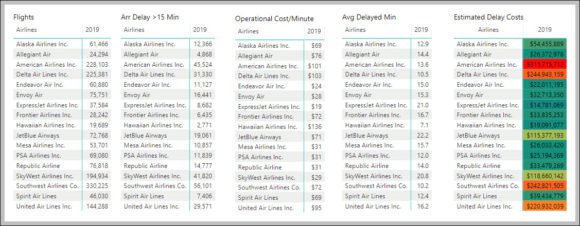
2019 07 10 8 05 55
Looking at the first four months of 2019, we estimate the US airline industry lost $1,891,777,148 from arrival delays. The table below explains how we get to this number. Subscribers can view our updated model here.
Flights that land within 15 minutes of scheduled time are regarded as “on-time”. This is the number of flights listed in the second table (from the left). But that is a loose number. It gets even looser when one considers airlines pad their schedules to give them more time to arrive “on-time”. The second from the right table, Average Delayed Minutes, is defined as “Difference in minutes between scheduled and actual arrival time. Early arrivals show negative numbers.” Since this time is covers all flights (as defined by schedule) we apply this to our estimate. Moreover, we calculate our estimate against schedule – if a flight is one minute behind schedule that minute is, on average, a lost $76. Lost time is not free.
If we were to use the 15-minute rule, we estimate industry lost value from arrival delays would only be $25.3m for the first four months of 2019. The large difference in the value is that by using the 15-minute rule, in 2019 only 18.9% of the flights qualify as delayed. In the table above (second from right) one can see how few flights fall outside the 15-minute rule, qualifying them as late. And it is interesting to note that even this number has been rising: 2017 – 18.1%, 2018 – 18.8%. Industry associated costs are estimated at $84.5m and $103.2m respectively.
Airlines run according to a schedule; there is a beat to the business. Everything rotates around the schedule and anything that upsets schedule almost always incurs costs. More fuel burn, longer labor hours – the list goes on. Based on the 2019 data the average US airline costs $76 per minute to run and the average flight arrives 14.1 minutes behind schedule. Multiplying that over the volume of flights per day is why the costs are so high.
To get an idea of how important schedule is to an airline, watch this 2013 presentation from then EVP US Airways, Robert Isom. It was fascinating then and remains highly insightful. It was the best presentation made that day, in our view.
Today Robert Isom is President at American Airlines Group.
The four months reported consist of 119 days. During the period the US passenger airlines averaged $15.9m in costs per day from delayed arrivals. That is not counting lost passenger time – which is also not free. For comparison, the industry incurred $20.2m in delayed arrival costs per day in 2018. The 2017 number was $16.4m per day.
These costs might be recoverable through better schedule management. One has to consider airlines face schedule disruption from all sorts of exogenous factors. Still, schedule management that allows for padding eats up valuable time. The clock ticks and the dollars add up. Taking out excess block time could, possibly, even add another revenue leg for the day. Aircraft make money when they fly. If costs per minute are so significant, imagine how much greater the total financial impact would be if airlines recover some of those lost minutes and turn that into revenue? What airlines do with each of the 1,440 daily minutes matter.
Views: 9





